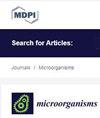从哥伦比亚加勒比红树林中的 Avicennia germinans 分离出耐受 Hg2+ 的内生细菌 Priestia flexa 7BS3110
IF 4.1
2区 生物学
Q2 MICROBIOLOGY
引用次数: 0
摘要
大西洋省(哥伦比亚加勒比海地区)的红树林生态系统受到海水过咸和污染问题的严重威胁,尤其是来自马格达莱纳河的重金属污染。红树植物已经发展出各种机制来适应这些压力条件,以及有利于其生长的相关微生物种群。在本研究中,研究人员对从大西洋省巴尔博亚沼泽的 Avicennia germinans 物种中分离出来的耐盐内生细菌对重金属(尤其是汞)的耐受性和解毒能力进行了鉴定。从经过表面消毒的 A. germinans 叶片中分离出了多种微生物。评估了每个分离物对 NaCl 的耐受性,并选择了耐受性最强的一个来评估其对 Pb2+、Cu2+、Hg2+、Cr3+、Co2+、Ni2+、Zn2+ 和 Cd2+ 的耐受性,其中许多物质在研究地区都检测到了高浓度。根据 ANI 和 AAI 百分比,耐卤能力最强的菌株被确定为柔性普氏菌(Priestia flexa),命名为柔性普氏菌 7BS3110,它能耐受高达 12.5%(w/v)的 NaCl,对 Hg 的最低抑制浓度(MICs)为 0.25 mM,对 Pb 的最低抑制浓度(MICs)为 10 mM,对 Cr3+ 的最低抑制浓度(MICs)为 15 mM。对 P. flexa 7BS3110 基因组的注释显示,存在与外多糖(EPS)生产、硫醇生物合成、铬外流特异性蛋白、铅外流非特异性蛋白以及硫和铁平衡过程相关的蛋白质序列。扫描电子显微镜(SEM)分析表明细胞形态发生了变化,透射电子显微镜(TEM)显示暴露于 0.25 mM Hg2+ 时细胞外出现了电致密层。由于 P. flexa 7BS3110 对 Hg2+ 和 NaCl 有很高的耐受性,因此测试了它在这两种胁迫下的生长能力,结果表明它能在 5%(w/v)NaCl 和 0.25 mM Hg2+ 的条件下茁壮成长。此外,当接触浓度为 14 毫克/升的 Hg2+ 时,它能从培养基中去除 98% 的 Hg2+。P. flexa 7BS3110 具有生物修复嗜 Hg2+ 卤污染生态系统的潜力。本文章由计算机程序翻译,如有差异,请以英文原文为准。
Halotolerant Endophytic Bacteria Priestia flexa 7BS3110 with Hg2+ Tolerance Isolated from Avicennia germinans in a Caribbean Mangrove from Colombia
The mangrove ecosystems of the Department of Atlántico (Colombian Caribbean) are seriously threatened by problems of hypersalinization and contamination, especially by heavy metals from the Magdalena River. The mangrove plants have developed various mechanisms to adapt to these stressful conditions, as well as the associated microbial populations that favor their growth. In the present work, the tolerance and detoxification capacity to heavy metals, especially to mercury, of a halotolerant endophytic bacterium isolated from the species Avicennia germinans located in the Balboa Swamp in the Department of Atlántico was characterized. Diverse microorganisms were isolated from superficially sterilized A. germinans leaves. Tolerance to NaCl was evaluated for each of the obtained isolates, and the most resistant was selected to assess its tolerance to Pb2+, Cu2+, Hg2+, Cr3+, Co2+, Ni2+, Zn2+, and Cd2+, many of which have been detected in high concentrations in the area of study. According to the ANI and AAI percentages, the most halotolerant strain was identified as Priestia flexa, named P. flexa 7BS3110, which was able to tolerate up to 12.5% (w/v) NaCl and presented a minimum inhibitory concentrations (MICs) of 0.25 mM for Hg, 10 mM for Pb, and 15 mM for Cr3+. The annotation of the P. flexa 7BS3110 genome revealed the presence of protein sequences associated with exopolysaccharide (EPS) production, thiol biosynthesis, specific proteins for chrome efflux, non-specific proteins for lead efflux, and processes associated with sulfur and iron homeostasis. Scanning electron microscopy (SEM) analysis showed morphological cellular changes and the transmission electron microscopy (TEM) showed an electrodense extracellular layer when exposed to 0.25 mM Hg2+. Due to the high tolerance of P. flexa 7BS3110 to Hg2+ and NaCl, its ability to grow when exposed to both stressors was tested, and it was able to thrive in the presence of 5% (w/v) NaCl and 0.25 mM of Hg2+. In addition, it was able to remove 98% of Hg2+ from the medium when exposed to a concentration of 14 mg/L of this metalloid. P. flexa 7BS3110 has the potential to bioremediate Hg2+ halophilic contaminated ecosystems.
求助全文
通过发布文献求助,成功后即可免费获取论文全文。
去求助
来源期刊

Microorganisms
Medicine-Microbiology (medical)
CiteScore
7.40
自引率
6.70%
发文量
2168
审稿时长
20.03 days
期刊介绍:
Microorganisms (ISSN 2076-2607) is an international, peer-reviewed open access journal which provides an advanced forum for studies related to prokaryotic and eukaryotic microorganisms, viruses and prions. It publishes reviews, research papers and communications. Our aim is to encourage scientists to publish their experimental and theoretical results in as much detail as possible. There is no restriction on the length of the papers. The full experimental details must be provided so that the results can be reproduced. Electronic files and software regarding the full details of the calculation or experimental procedure, if unable to be published in a normal way, can be deposited as supplementary electronic material.
 求助内容:
求助内容: 应助结果提醒方式:
应助结果提醒方式:


